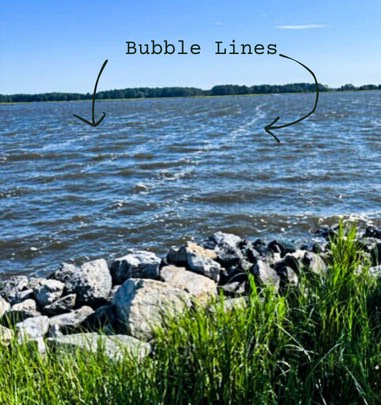For millennia, the outside environment played a vital role in human survival. Whether they were farmers or fishermen or sailors, most people’s lives revolved around the weather.
Today, however, we go from our climate-controlled house to our air-conditioned car to our climate-controlled office and back again. The weather plays a very small role in our day-to-day existence. And sadly, most of us have lost the ability to read the wind.
But for any outdoor activity, from sailing to pickle ball, the weather, especially the wind, is a major factor. Being able to read the wind’s direction and velocity, especially in water sports, can be the difference between an enjoyable, safe adventure, and a disaster.
Before the days of wind meters and phone apps, watermen used The Beaufort Scale to communicate wind velocity. Developed in 1805 by Sir Francis Beaufort of the UK Royal Navy, it is a scale that uses visual clues to determine wind speed. For example, you’ll see small scattered whitecaps with Force 3 winds (7-10 knots). With Force 6 winds (22 – 27 knots), you’ll see large tree branches swaying and hear the wind whistling through wires.
Wind apps have come a long way. But they rarely give the hyper-local data needed for route planning for human powered craft. Paying attention to your environment, as watermen did in the past, is really the key to learning to read the wind. Clues are all around us – all we have to do is open our eyes.
What are some clues as to what the wind is doing? Flags, trees, texture on water, smoke, clouds, birds (yes birds), planes, sprinklers – the list goes on and on. Let’s talk about some obvious ones:
Flags
Flags can be good indicators of both wind speed and direction. The higher the flag and the less blocked it is by buildings or trees, the more accurate it will be. However, sometimes flags will deceive you. When wind comes around a large obstacle (a building, for example) it reverses direction on the downwind side (like an eddy in the water) and blows towards the obstacle. This makes it look like the wind is coming from the opposite direction.
Smoke
If smoke is going straight up, it means very little wind. If it is blowing at a right angle from the source, the wind is strong. And the path of the smoke trail is a very accurate indicator of direction.
Birds
Have you ever noticed that birds always stand facing into the wind? Look at a flock of shorebirds on the beach on any windy day and you will notice they are always pointing the same direction – directly into the wind.
Planes
Have you ever looked closely at the banner planes as they fly over? If you compare their path with the clouds behind them, you’ll notice that many times they look as if they are going sideways. That’s because they are getting pushed by the wind and must point more into the wind to compensate.
Water
Water gives us the best clues. If you are standing on a shoreline looking out at the water and the wind is hitting your back, the water will look smooth, with very little texture, and will appear light. But if you were on the other shoreline looking into the wind, the water will look choppy and dark. This example is explained by a term called “fetch,” a concept that anyone that paddles should be familiar with.
I pass some small shallow salt marsh ponds on my route to work. Out of habit, I always note the texture of the water. Near the marsh on the side of the pond from where the wind is coming, the water will be perfectly calm and glassy. The opposite side will have some texture. Voila, I already know the wind direction and I haven’t even gotten to work yet.

Lines in the water are perhaps the best source of determining wind direction. They may appear as dark lines, light lines or bubble lines. They may be from wind gusts, wind channels, areas of wind lulls, etc. If there is enough wind to create small whitecaps, you will have bubbles in the water and guess what? They, just like most lines, will run in the same direction as the wind – a perfect wind vane on the water.


Clues to wind speed and direction are all around us, all the time. We just have to be observant – and a little curious – to start noticing them.
Mitch Mitchell
USCG Captain
ACA Level 4 Instructor Trainer
